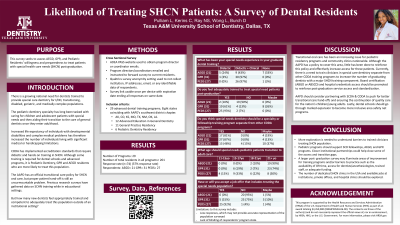Special Health Care Needs
185 - Likelihood of Treating SHCN Patients: A Survey of Dental Residents


Lianna Pulliam, pulliam@tamu.edu (she/her/hers)
Resident
Texas A & M University -—Baylor College of Dentistry, Dallas, TX
Texas A & M University -—Baylor College of Dentistry, Dallas, TX
Dallas, Texas, United States- CK
CAROLYN KERINS, DDS
TEXAS A&M
- DB
DAN BURCH, DDS
TEXAS A&M
- NR
NINA RAY, DDS
TEXAS A&M
- DB
Dan Burch, DDS
Texas A&M/Baylor
Dallas, Texas, United States - CK
Carolyn Kerins, DDS, PhD
Associate Professor & Grad Program Director
Texas A&M University School of Dentistry
Dallas, Texas, United States
Presenting Author(s)
Co-Author(s)
Research Mentor(s)
Program Director(s)
Background: There is a growing national need for dentists trained to provide special care dentistry for I/DD, transitioning, disabled, geriatric and medically complex populations.
Purpose: This survey seeks to assess AEGD, GPR and Pediatric Residents’ willingness and preparedness to treat patients with special health care needs (SHCN) post-graduation.
Methods: Institutional emails for 29 advanced dental training programs (12 AEGD, 11 GPR, 6 Pediatric) from eight states (AK, CO, KS,MO, TX, NM, OK, LA) coinciding with AAPD’s southwest district chapter were included in this survey. An email explaining the electronic survey was sent to the program directors asking that they forward the link to the survey to their current residents. Qualtrics survey anonymity function did not collect institution, IP addresses, email or any identifiable data of respondents. Survey link usable once per device with expiration date ending all responses on same date.
Results: 74 residents of 201 in all included programs (21 AEGD, 31 GPR 27 Pediatric, 74/201= 34% response rate). 57% of AEGD residents report receiving none or didactic only special needs training. 97% of GPR and pediatric residents report receiving clinical and didactic special care training. 90% of AEGD residents do not feel adequately trained to treat special needs patients after graduation. 61% GPR and 93% of pediatric residents report adequate training to treat this population. When asked if SCD should be a specialty or separate training program AEGD 100% of AEGD and GPR residents and 85% or pediatric residents responded yes or maybe. 90% of AEGD, 74% of GPR report age of transition to adult care should be over 21. 95% of AEGD and 75% of GPR residents do not plan to accept a job treating special care patients, 92% of pediatric residents plan to.
Conclusions: More exploration is needed to understand barriers to trained clinicians treating SHCN population. Pediatric programs should support SCD fellowships, AEGD, and GPR programs. Closer institutional partnerships could help close some of the access and transition gaps. A larger post- graduation survey may illuminate areas of improvement for training programs and/or barriers to practice such as the availability of OR time, access for dentists/anesthesiologists, trained staff, or adequate funding. The number of dedicated SHCN clinics in the USA and available jobs at institutions, private offices, and hospital clinics should be explored.
Identify Supporting Agency and Grant Number: N/A

.jpg)